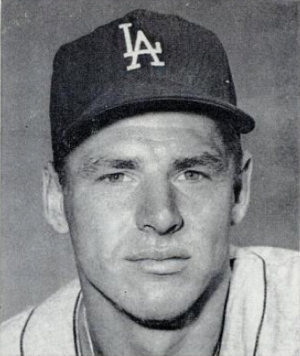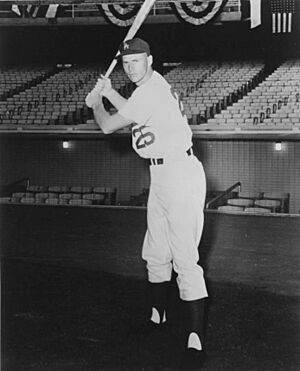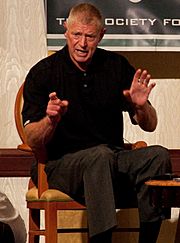Frank Howard (baseball) facts for kids
Quick facts for kids Frank Howard |
|||
|---|---|---|---|

Howard with the Los Angeles Dodgers in 1962
|
|||
| Outfielder / First baseman | |||
| Born: August 8, 1936 Columbus, Ohio, U.S. |
|||
| Died: October 30, 2023 (aged 87) Aldie, Virginia, U.S. |
|||
|
|||
| debut | |||
| September 10, 1958, for the Los Angeles Dodgers | |||
| Last appearance | |||
| September 30, 1973, for the Detroit Tigers | |||
| MLB statistics | |||
| Batting average | .273 | ||
| Home runs | 382 | ||
| Runs batted in | 1,119 | ||
| Teams | |||
As player
As manager
As coach
|
|||
| Career highlights and awards | |||
|
|||
Frank Oliver Howard (born August 8, 1936 – died October 30, 2023) was a famous American baseball player. People knew him by cool nicknames like "Hondo", "the Washington Monument", and "the Capital Punisher". He played most of his career in Major League Baseball for the Los Angeles Dodgers and the Washington Senators.
Frank Howard was a really big player, standing at 6 feet 7 inches tall and weighing around 275 to 290 pounds. He was known for his powerful hitting. In 1960, he was named the National League's Rookie of the Year while playing for the Dodgers. He also led the American League in home runs twice during his career.
Contents
Early Life
Frank Oliver Howard was born in Columbus, Ohio. He was one of six children. His dad worked on the railroad and had played some baseball himself. He really encouraged Frank's love for the game.
Frank went to South High School and then Ohio State University. He was amazing at both college baseball and college basketball for the Ohio State Buckeyes. He was even named an All-American in both sports! In 1957, he scored about 20 points and grabbed 15 rebounds per game in basketball. The Philadelphia Warriors of the National Basketball Association even drafted him to play basketball.
Professional Baseball Career
Playing for the Los Angeles Dodgers
Even though he was drafted for basketball, Frank Howard chose to play baseball. He signed with the Los Angeles Dodgers. In 1958, he played in the minor leagues and hit 37 home runs. The Dodgers then called him up to the major leagues.
In 1960, Frank became the Dodgers' main right fielder. He was named the National League's Rookie of the Year. He hit 23 home runs and had 77 RBIs that year. His teammates started calling him "Hondo" after a character in a John Wayne movie.
Frank continued to hit many home runs for the Dodgers. In 1962, he hit 31 home runs and had 119 RBIs. He was even named the National League Player of the Month in July, hitting 12 home runs and 41 RBIs!
In 1963, the Dodgers won the World Series. Frank hit a key home run in Game 4 against the New York Yankees, helping his team win the championship. However, the Dodgers' new stadium, Dodger Stadium, made it harder for power hitters like Frank to hit home runs. The team also started to prefer faster outfielders.
Playing for the Washington Senators
In 1964, the Dodgers traded Frank Howard to the Washington Senators. This was a great move for him because he became an everyday player. In 1965, his first year with the Senators, he hit 21 home runs.
Frank had an amazing week in May 1968, hitting 10 home runs in just 20 tries! He ended that season leading the American League with 44 home runs. He also made his first of four straight All-Star teams. Around this time, he also started playing first base sometimes to help him stay healthy.
Ted Williams, a legendary hitter, became the Senators' manager in 1969. He helped Frank become an even better hitter. Ted taught him to be more patient and wait for the right pitch. This advice helped Frank get more walks and strike out less.
In 1969, Frank hit a career-high 48 home runs. He also had 111 runs scored and a great batting average of .296. The Senators had their best season ever that year. In 1970, Frank led the American League in both home runs (44) and RBIs (126). He also led the league in walks with 132, which is still a team record.
Frank hit the very last regular-season home run for the Senators at RFK Stadium on September 30, 1971. After hitting it, he waved to the fans, threw his hat into the stands, and blew a kiss. He later said it was one of the biggest thrills of his life.
Later Career
In 1972, the Senators team moved and became the Texas Rangers. Frank hit the first home run for the new Rangers team. Later that year, he was traded to the Detroit Tigers. He played his final major league season in 1973.
After his time in the U.S., Frank played one season in Japan for the Taiheiyo Club Lions in 1974. However, he hurt his back in his very first try and couldn't play anymore.
Over his 16 seasons in Major League Baseball, Frank Howard hit 382 home runs and had 1,119 RBIs. He was known for his powerful swings, which sometimes led to many strikeouts, but also to many home runs!
As Manager and Coach
After he stopped playing, Frank Howard became a coach for the Milwaukee Brewers from 1977 to 1980. Then, he became the manager for the San Diego Padres in 1981. He also managed the New York Mets for part of the 1983 season.
Frank also coached for many other teams, including the Brewers again, the Mets again, the Seattle Mariners, the New York Yankees, and the Tampa Bay Devil Rays. After 2000, he worked for the Yankees, helping young players develop their skills.
In 2005, baseball returned to Washington D.C. with the new Washington Nationals team. Frank Howard was there for the special opening day ceremony. He joked about how he used to sprint to left field and hoped he wouldn't have a "blowout" (get tired) just walking out there!
Frank also helped raise money for St. Jude Children's Research Hospital, which helps kids with serious illnesses.
Personal Life and Death
Frank Howard was married twice. He had six children with his first wife, Carol. He later married his second wife, Donna, in 1991.
Frank Howard passed away on October 30, 2023, at the age of 87. He died from problems related to a stroke.
See also
 In Spanish: Frank Howard para niños
In Spanish: Frank Howard para niños
- List of Major League Baseball career home run leaders
- List of Major League Baseball career runs batted in leaders
- List of Major League Baseball annual runs batted in leaders
- List of Major League Baseball annual home run leaders



